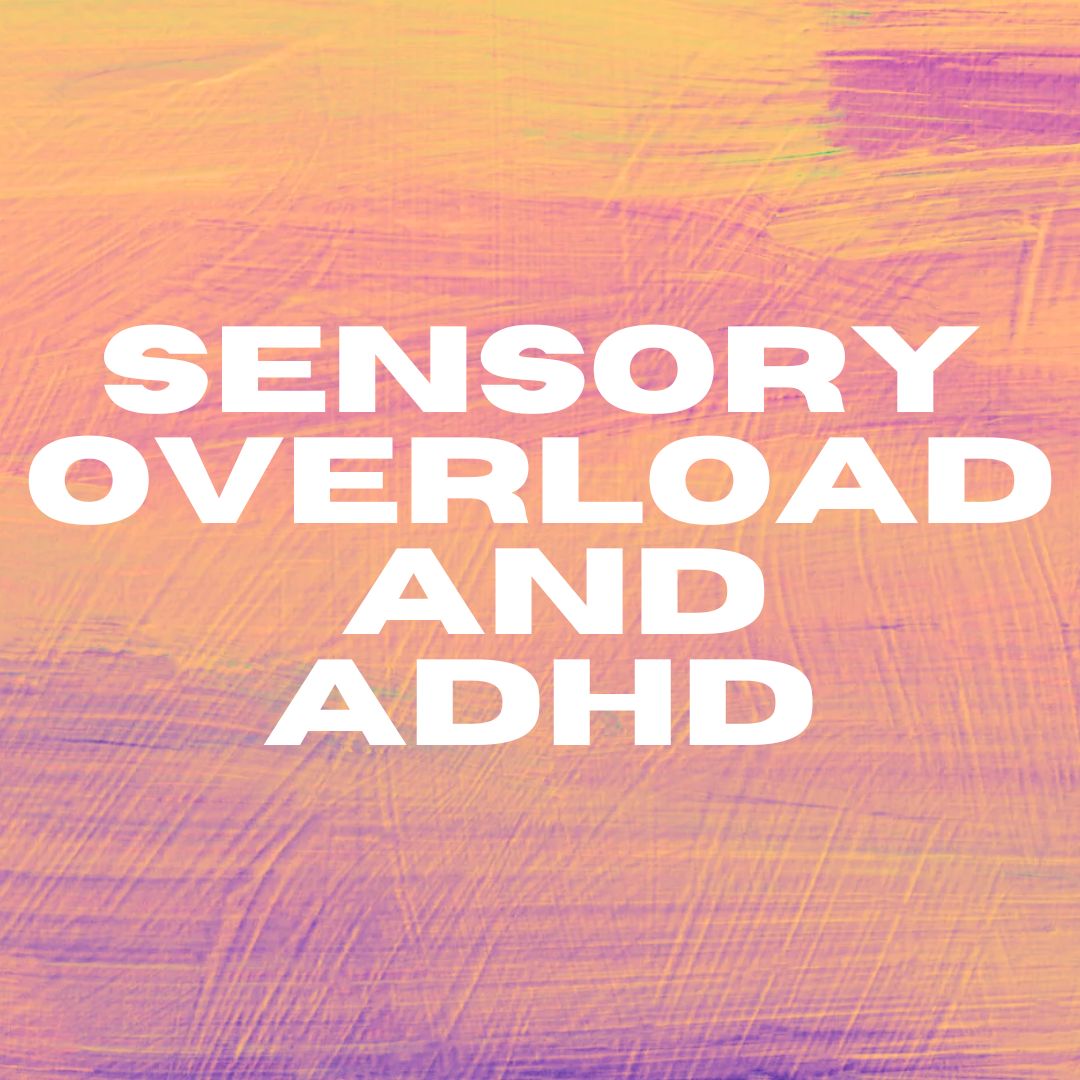
Sensory Overload and ADHD
An often-overlooked component to life with ADHD is the impact of sensory experiences. Sensory experiences include the way we feel through our five senses- touch, taste, smell, sound, and sight. People with ADHD often notice things in their environment that others more easily tune out and can hyper-focus on them, which makes them appear distracted. For example, imagine being in a restaurant and noticing the sound of someone scraping food off a plate. This is usually background noise, but for someone with ADHD, that sound becomes distracting and is all they can think about. When people think of sensory overload, this often brings up images that are associated with the stereotypes of Autism such as someone wearing headphones to help tune out that auditory stimulation. Autism and ADHD are two separate diagnoses, but there is some overlap between the two. Sensory overload is one of them, but since this is more commonly associated with Autism, many people with ADHD are unaware they are being impacted in this way. A byproduct of these misunderstandings and internalized stereotypes is that they minimize the impact that sensory overload can have and what that can look like.
Common thoughts associated with shaming sensory overload are:
“You are SO sensitive!”“You are SO picky!”“You just always need to have your way!”
Over time, this can develop into:“I have control issues.”“I prefer to work alone.”
Modern life brings a bombardment of sensory input. Our phones, workspaces, shopping spaces, learning spaces, and common living areas are always shining, dinging, clicking, and humming. Sensory overload can bring feelings of anxiety, especially in new situations or environments where we have little control. It can look and feel like we want to control things, which can impact relationships. Behind the scenes, it isn’t that we want to control things and appear irritated by other people and other approaches. We want to feel comfortable. Learning more about how sensory input may be contributing to your feelings of overwhelm and how to reduce the negative impact can help improve your sense of wellbeing.
White Shirt Dilemma
I went to Catholic school, which meant I had to wear a school uniform. My mom used to say she loved that we had uniforms because then she didn’t have to deal with the fuss about what we were gonna wear to school. I didn’t have to adhere to any certain brand, but I had to wear a white, long sleeve shirt. I had about 6, but 2 were my favorite. At the time, I didn’t give thought as to why, I just liked them better. They felt better. I strongly preferred them. Sometimes I would be upset if they were not washed. My mother had her reasons for not wanting me to use the washer myself. If it were up to me, I would have done laundry every two days to always have my preferred shirt. Instead, we fought about it. I was being too picky. My mother remained steadfast that “A white shirt is a white shirt!” Why did I deserve special treatment regarding the laundry? Why did I insist on being difficult?
Looking back, I now know this is an example of sensory overload. Something about the material in the other white shirts made me uncomfortable. I didn’t like the way they felt. It made me feel self-conscious. It is hard to trust yourself when someone is telling you that the way you feel about things is something to be ashamed of. This becomes internalized and we learn to cope in unconscious ways. To an extreme degree, one way I might have unconsciously coped with having to wear a shirt to school that made me uncomfortable would have been to not go to school. Maybe I had a headache or stomachache. I wasn’t actively thinking, “Oh yeah, well, I’m not going to school if I can’t wear that shirt!”
When talking to parents about sensory issues, it is not uncommon for parents to be concerned that their kid is going to grow up and be “picky”. They think their role as a parent means getting their child to tolerate wearing the white shirt they don’t like. They don’t want their child to be labeled as difficult or to have a hard time. It is better to accept sensory issues as part of someone’s identity and help them learn coping skills to reduce the impact that sensory issues can have on their quality of life. Sensory issues can be much easier to navigate as an adult when you aren’t having to meet the expectations of authority figures in the same way we do as children. They are not easier to navigate if we aren’t aware that we experience them.
I suggest doing a sensory inventory. What have you unconsciously been tolerating that you don’t have to anymore? Can you make related adjustments now that you have more control?
For example, as an adult, I would toss out white shirts that made me that uncomfortable. I would either buy a week’s worth of my preferred shirt or adjust my laundry schedule. Let’s look at some sensory issues that might be associated with clothing.
Clothing: Think of your everyday wardrobe. For this exercise we are not going to think of clothing preferences based on seasonal or occasion. We are not going to think of organization in terms of storage or space.
What clothes do you own that you never wear?
What clothes do you wear the most often?
Have you ever thought about your wardrobe choices based on how the clothes feel? Do certain weights or fabrics feel soothing and comfortable? Are there certain textures that bother you?
Necklines- do they feel suffocating? Is that why you unconsciously avoid wearing that shirt?
Do materials feel too heavy? Too thin? Too scratchy?
Hem lines- do they hit your ankles or legs in ways that you do not like the feel of?
Jewelry/accessories- do earrings feel too heavy? Do certain bracelets styles feel uncomfortable?
Potential benefits
Releasing feelings of shame
If you pare down your wardrobe to the things you actually wear, that eliminates the shame from owning stuff you don’t wear because you don’t want to feel “wasteful” or “ungrateful”. It eliminates the shame from things not fitting properly. It eliminates the shame we might associate with a bad or stressful event that happened and we see the outfit we were wearing. A common development resulting from undiagnosed ADHD and related relational and emotional traumas is that we are taught to believe any discomfort is our fault, making feelings of shame the default. This is also reinforced by society. By identifying your actual wants and needs and prioritizing them, this helps quiet the shame response. We eliminate the clothing source of shame.
Eliminating decisions=increased mental energy
When you are picking up on everything, it can be overwhelming, and it can be hard to prioritize. One method is figuring out what you DON’T want. This eliminates a lot of categories and possibilities with decision making. By using this sensory inventory, you can eliminate clothing options, thus allowing your mind to focus on other tasks. This can be used for other daily encounters.
Are there foods you don’t like? Skincare products you used a dollop of and never touched again? Scents that give you a headache? Pens or utensils you hate the feel of?
Do you have other options? That means the things you don’t like can go. No guilt. It isn’t your fault you have a neurodivergent brain in a for profit world with endless options.
Things to try
Getting rid of what doesn’t serve you gives more room and space for the things that do. Here are some common sensory friendly ideas to check out!
Loop earplugs– may reduce sensory input from sound
Blue light glasses- may reduce visual sensory input from screens or fluorescent lights.
Fidget rings, calm strips– sensory stimulation tools that can help regulate energy
Look for sensory friendly hours that may be offered for certain events or stores. For example, Walmart offers low sensory hours that include lower lights and reduced audio from tv and radio. I subconsciously developed the habit of preparing myself to enter Walmart expecting to leave in a terrible mood and one day I noticed I left there feeling great! Turns out, I was there during low sensory hours.
These are all things I would put on the “can’t hurt, might help” list of ways to try to minimize the sensory overload struggles with ADHD. If it inspired any others, please let me know!

